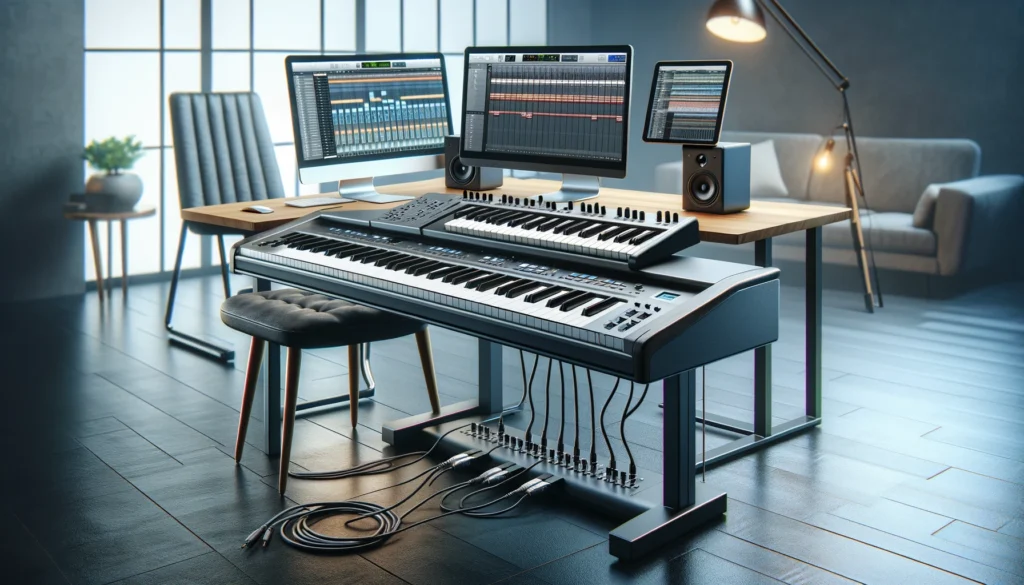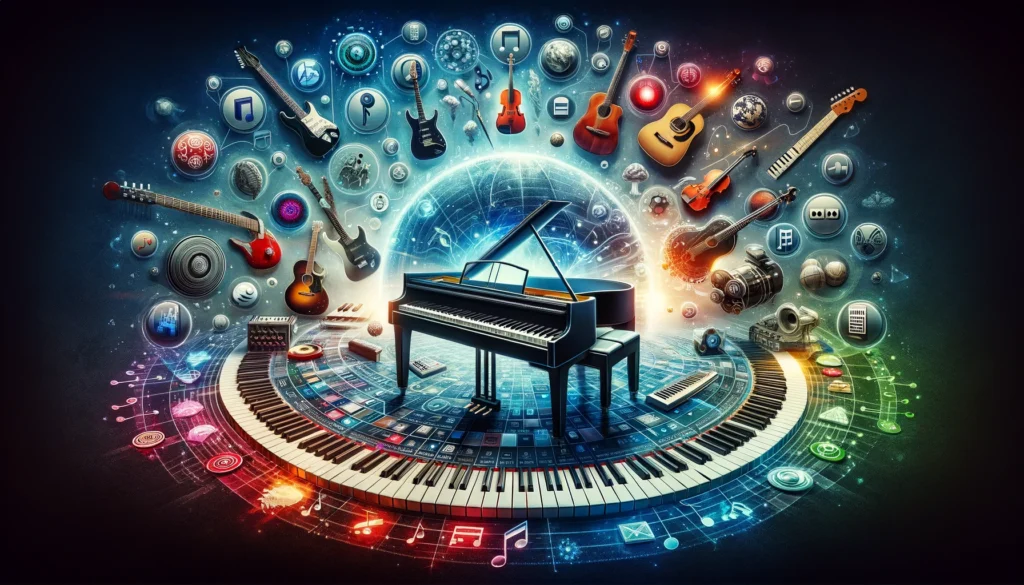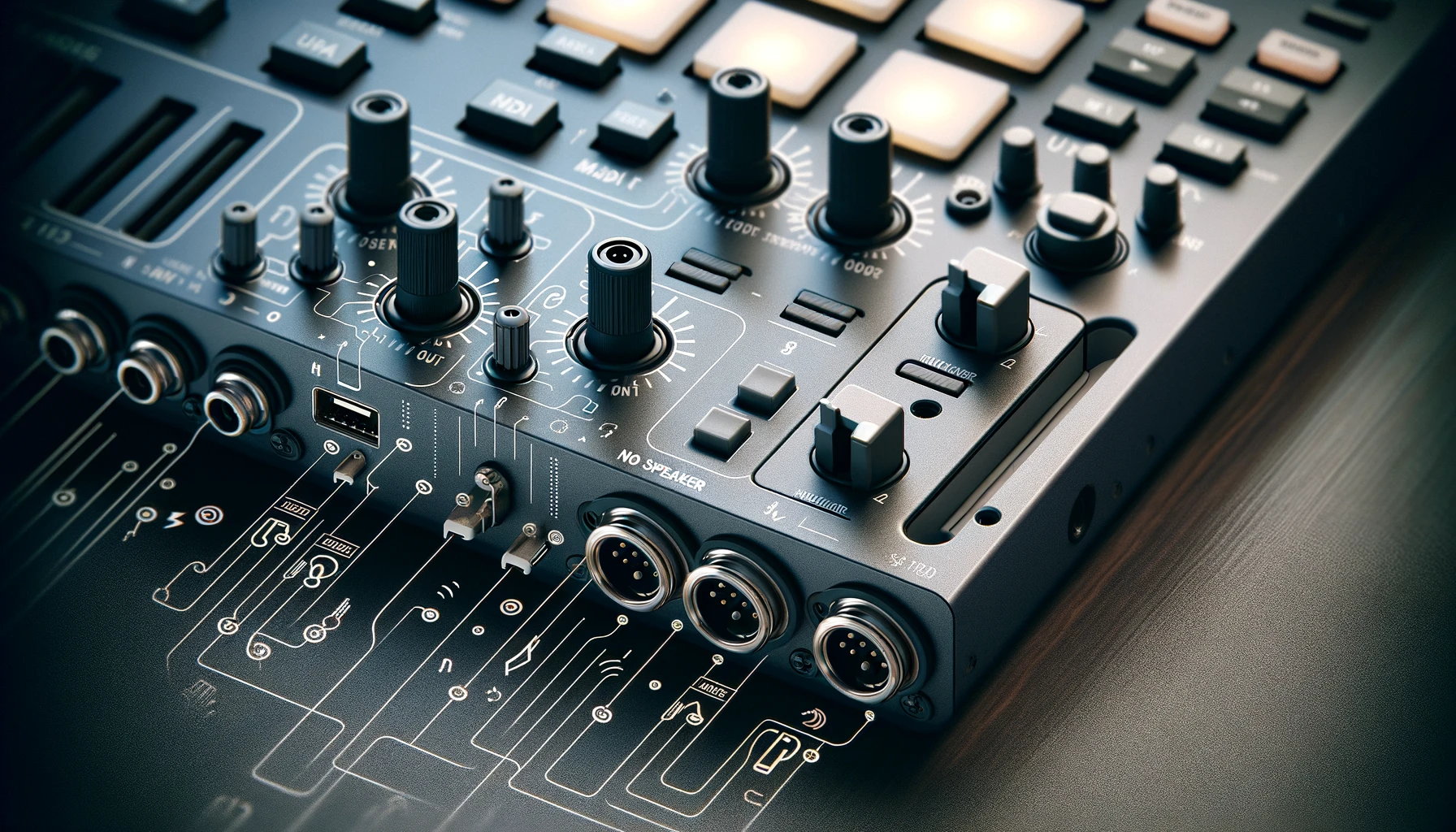Have you ever wondered if your digital piano can do more than just emulate acoustic piano sounds? The versatility of digital pianos is far greater than meets the eye.
In fact, digital pianos can readily double as full-featured MIDI controllers to operate virtual instruments, music production software, lighting rigs and more.
Let’s dive in to understand what MIDI is, how to connect your digital piano via MIDI, and the many benefits this unlocks…
Can a Digital Piano Be Used as a MIDI Controller?

Yes, absolutely.
By connecting a digital piano to a computer, iPad, or MIDI devices using MIDI cables or USB, the keyboard, pedals, and buttons on the piano can be mapped to control parameters on those devices.
This powerful MIDI functionality transforms the digital piano into a highly expressive controller. We’ll explore below how to tap into this potential.
What is a Digital Piano?

A digital piano is an electronic instrument that mimics an acoustic piano.
Digital pianos produce piano tones digitally using recordings or modeling, rather than by striking strings like an acoustic piano does.
Digital pianos feature weighted or semi-weighted keys that attempt to recreate the feel of a real piano keyboard.
Compared to real pianos, digital pianos tend to be more portable and affordable.
Digital pianos contain keyboard electronics and digitally created sounds rather than the strings and hammers found in acoustic pianos.
The keyboards aim to simulate the feel of an acoustic piano through graded hammer-action key weighting.
High-end digital pianos use complex modeling to capture nuances of real piano tones, while cheaper models may rely on basic recordings.
What is MIDI?

MIDI stands for Musical Instrument Digital Interface.
It is a technical standard that allows digital musical instruments, computers, tablets, smartphones and other equipment to connect with each other and communicate.
The main purpose of MIDI is to enable instruments to control one another.
For example, MIDI allows a keyboard to send signals to a computer telling it which notes to play and how loud or soft each note should be.
This is different from an audio signal, which would simply capture the sound directly.
Instead of transmitting an audio recording, MIDI transmits performance data.
This MIDI data contains messages that allow musical input devices like keyboards to act as controllers, telling synthesizers or computer software what notes to generate and how they should sound.
MIDI messages can specify parameters like pitch, velocity, vibrato, panning, and clock signals that set tempo.
A single MIDI cable can carry up to sixteen channels of information.
This enables comprehensive control of myriad parameters on the receiving device.
How To Connect A Digital Piano via MIDI

Most digital pianos have MIDI in/out jacks, usually labeled as MIDI IN and MIDI OUT.
These allow the digital piano to be connected to other devices using special MIDI cables.
Alternatively, many digital pianos also have USB ports which can connect to computers and allow MIDI data transmission over USB.
To connect the digital piano to a computer, you would need a USB device host interface or a USB MIDI interface.
With the piano and computer connected vis MIDI interfaces and cables, the piano is then able to send and receive MIDI data.
On one end, the MIDI cable gets plugged into the MIDI OUT port of the digital piano.
On the other end, the cable gets connected to the MIDI IN port of an external device, like a computer running a digital audio workstation (DAW) program and virtual instrument software, a standalone synthesizer, or a MIDI sequencer.
Once connected, the digital piano can then send MIDI data through the cable to the external device by playing notes on the piano’s keyboard.
This MIDI data gets interpreted by the external synth or software, triggering notes and sounds.
How To Use A Digital Piano as a MIDI Controller

Connecting a digital piano via MIDI allows it to be used as a MIDI controller.
This involves harnessing the piano as an input device, sending MIDI data from it to control other MIDI-compatible synthesizers, virtual instruments, DAW software, lighting rigs, and more.
The keyboard, pedals, and buttons on the digital piano can all be mapped to different parameters on the devices receiving the MIDI data.
This enables the piano to directly shape the sound coming from the downstream devices.
For example, by connecting a digital piano to production software on computer via MIDI and assigning the piano’s keyboard to control a virtual grand piano instrument within the software, the keys, velocity sensitivity, pedaling, and other controllers on the real piano can shape all aspects of the virtual piano tones generated on the computer.
The keyboard playing gets captured as MIDI data via the digital piano’s keys, converted to digital signals, transmitted via the interface into the software, and finally translated back into musical results through the virtual instrument.
What Are The Benefits of Using a Digital Piano as a MIDI Controller?

There are several advantages to using a digital piano as a MIDI controller rather than a standard MIDI keyboard or dedicated MIDI controller.
Since digital pianos are designed primarily to play and sound like real acoustic pianos, they provide a very realistic piano playing experience that standard MIDI controllers do not.
This allows for nuanced piano-style playing techniques leveraging the keyboard’s graded hammer-action weighted keys, making the piano MIDI controller much more expressive and dynamic.
Another major benefit is that using a digital piano as the MIDI controller gives you access to a wider variety of sounds.
By controlling external MIDI devices, you can make the piano play all sorts of synthesized and sampled sounds that its onboard sound engine likely can’t produce.
The MIDI routing also allows recording piano playing data into DAW software for advanced editing and sound design.
Additionally, using an existing digital piano as a controller saves money compared to buying dedicated MIDI keyboards and controllers, which are usually quite pricey.
It also allows you to leverage equipment you likely already own if you have a digital piano.
This saves both money and space.
Lastly, using a digital piano MIDI controller improves mobility.
Since the sounds are generated from external connected devices, you simply need to bring the piano controller itself without any onboard speakers or amplification to control those devices remotely.
This enables easily transporting your piano controller anywhere to control software instruments on a laptop or iPad, for example.
Considerations When Using a Digital Piano as a MIDI Controller
While there are many excellent reasons to use digital pianos as MIDI controllers, there are also some limitations to note.
These considerations should be weighed when deciding whether to pursue this route.
The keyboard actions on most digital pianos are designed primarily to emulate the feel and playing experience of an acoustic piano.
While weighted graded hammer-action keys succeed at mimicking piano touch, they may not be ideal for very fast, organ-style, or synth-style playing that involves quick repetition.
The action may feel too heavy and bouncy for virtuosic runs best suited to light synth keyboards with waterfall keys.
Additionally, many digital pianos lack extra controls like pitch wheels, modulation wheels, or drum pads usually found on dedicated MIDI controllers.
There can also be a learning curve involved with setting up the required MIDI connections and routing, assigning instruments to the controller, getting levels matched, reducing latency, and figuring out which messages should be mapped to which controls.
Those new to MIDI implementation may find this complicated at first.
Latency – a slight delay between playing a key and hearing the sound – can potentially be an issue during recording if using slower computer processing.
Latency results from the extra time needed for the MIDI data transmission process.
While often negligible, noticeable latency can make precise timing of rapid parts challenging.
Conclusion
In summary, digital pianos can readily moonlight as MIDI controllers – gaining tremendous flexibility to shape a wide palette of instruments, software, and other equipment via MIDI connections.
Their realistic weighted hammer-action keyboards offer nuanced dynamic expression unattainable by typical MIDI keyboards.
Unlocking your digital piano’s MIDI controller superpower brings unlimited creative possibilities to your musical workflow at little added cost.
